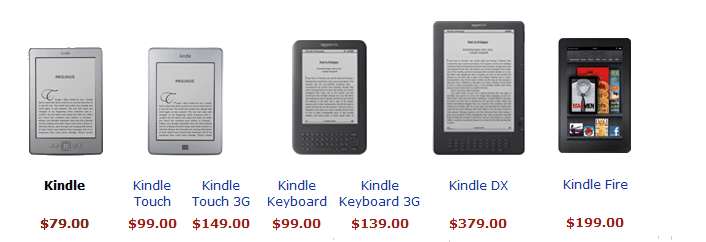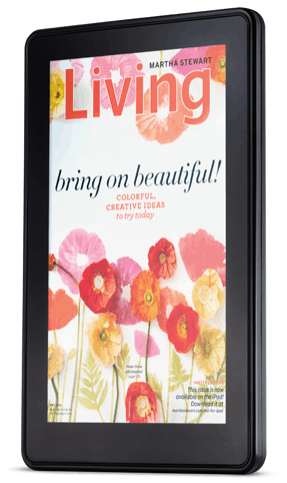| New Amazon Kindles - the developer's take |
| Written by Mike James |
| Thursday, 29 September 2011 |
|
Amazon is attracting attention for Fire and Silk - but where does the developer fit into the picture? If Microsoft's cry is "Developers, developers, developers", it seems Amazon's is "Go away, go away, go away". Amazon has announced a new range of Kindles and if you have been reading the tech news this will come as no surprise. Equally, given the offhand way that Amazon has treated the developer community with regard to Kindle, the fact that developers weren't mentioned at the launch will also come as no great surprise. Microsoft and Apple may both value the developer's input to their products, but Amazon gives the impression that at best they irrelevant and at worse a threat. Meet the family
First a few words on the unremarkable new hardware. Although it has been reported that four new Kindles have been launched we can simplify this to three versions of an ink-based device and a color tablet. The three ink based devices are very nice upgrades to the existing Kindle, but not a revolution. The entry-level Kindle is just a smaller lighter version with no keyboard, just a row of mechanical buttons. If you want a keyboard then you buy the original Kindle, now rebranded the "Kindle Keyboard", which is still going to be sold for a while, along with the bigger DX. The new Kindle is WiFi only. The new Kindle Touch puts an IR touch sensor on the screen and does away with the mechanical buttons. You can buy the Touch in two versions - WiFi only or WiFi + 3G. The Kindle Keyboard is also available in two versions - WiFi only or WiFi+3G. Then, there is the original DX with a larger, 9.7-inch screen. Notice that all of the other Kindles have a much smaller, 6-inch, screen. Finally there is the new Kindle Fire which has a color touch screen. At this point you can now settle back and try to figure out which Kindle is for you by arguing the subtle differences between them. The point is the bigger choice comes down to ink screen or color, touch or no touch and finally WiFi only or with 3G and, oh yes price. On the topic of price you need to notice that the prices quoted in the headline news are for the Special Offer versions, i.e. with advertising, except for the Fire and the original DX. If you want a completely ad-free Kindle then you need to add about $30 to the headline prices which make the entry level Kindle $109 not $79. The Kindle Fire is $199 without any advertising support, which is a puzzling omission.
(click above to expand) The ink-based Kindles really are just more of the same, and so don't raise any new questions as far as users and developers are concerned. The Kindle Fire, on the other hand, seems at first sight to be a different beast and possibly something that opens up new opportunities. After all, it's an Android-based color tablet. Or is it? Amazon doesn't ever mention the "Android" word and, as far at the end user is concerned, this is just an ebook reader that does some, but not much, extra stuff. As a tablet it look distinctly short on features. It doesn't have a camera, SD storage, GPS, accelerometer or anything above the basic processor, memory and display. There is a USB connection and WiFi but that's about it as far as "features" go. Another big question is why all of the screens are so small? Only the aging DX is big enough to read a good technical manual or lavish illustrated book. Has Amazon has settled for such a small screen for the Kindle family simply because most of the ebooks it sells are paperback format? SilkAbout the only major extra beyond what an ebook reader needs is the Silk browser. This is only available on the Fire and it basically uses the Amazon EC2 processors to fetch the web page, package it and send it in one efficient download to the device. This is not new as there are many services offering prepackaged compressed downloads over slow internet connections. It has the potential, however, to make the best of a slow connection and take note of your browsing habits and use them to predict what you might browse (or buy) next. I wouldn't be surprised to see Silk rolled out on other platforms simply for its market intelligence value. Amazon has already registered a set of URLs like silkforPC. Silk isn't so much new technology as basic marketing. Kindle, the consumerSo the point you have to get into your head is that the entire range of Kindles, including the so-called "Android tablet" Fire, are actually appliances to consume Amazon content. So if you want an ebook reader, music player, etc, then any of the Kindle range would do the job and if you also want color then the Fire is perfectly serviceable - but if you want a general purpose tablet computer, you need to look elsewhere. The Fire isn't an iPad killer. It isn't even a credible Android tablet killer. It is a good ebook appliance, however, and will probably be a Nook Color killer simply because of Amazon's bigger ebook market and the ease of buying and managing ebooks the Amazon way. You may not like it on principle, but it works and it's easy to get a book to read. If you want an ebook reader that is also an Android tablet then buy an Android tablet and install the Kindle reader software. After all it is what Amazon did to produce the Fire. Developers, developers, developers...So to return to the developer's point of view. The Kindle KDK was announced more than a year ago and has been in beta ever since. This might be OK but it's a closed beta and there has been little evidence that anything much has been happening. There have been a few Kindle applications, but nothing like the number there would be if there was an open beta, or even an open final release. If you visit the KDK website you will discover a single sentence announcing the new machines and promise of some news next week. What the news might be about is left in question, but I doubt it is the release of an open KDK - but I could be wrong. This is all the more surprising when you take into account the fact that Amazon has been making money out of Android apps. Again you may not like Amazon's policies for selling apps, but it has provided an additional choice for developers.The Fire is the only Kindle that can download apps from the Amazon app store and as such it behaves like a fairly standard Android 2.2 system with a lot of custom software running on top. As such the Fire isn't just an Android fork it's a Kindle fork as well. To build custom apps for the Fire you will need some additional information on the ebook reader layer etc. But for now, as long as you don't want to do anything spectacular, you can put apps on the Fire as long as it is via the frying pan of the Amazon store. Will the Fire move the whole Kindle family into the app store limelight and give developers a reason to develop Android tablet applications? Probably not. My guess, and it is only a guess, is that Amazon wants to keep the wider Kindle family as an ebook device and not a general purpose Android Tablet. If this is the case then developers are the enemy who could potentially make the platform a complete mess of buggy code. In fact, it is surprising that Amazon is even willing to allow apps on the Fire. Even if you don't share this point of view, there are still some big problems. Notice that the Kindle development system is the KDK and nothing to do with Android. It is generally assumed that the Fire is based on Android 2.2 with modification. As such how can an Android fork that is also a Kindle fork and based on a phone OS be expected to stimulate the Android tablet market? It can't - there is Android Honeycomb or Ice Cream sandwich and there is Kindle Fire. Your skills and your apps may be easy to transfer but they are not the same platform. We also have the problem that as a fork it isn't a tablet OS but a phone OS and what are they going to do about upgrades? Again guessing and extrapolating past experience with Kindle upgrades, the answer seems to be to "go it alone" and also upgrade as little as possible. This seems to be a true fork that will evolve on its own, making the gap bigger not smaller over time. There are so many unanswered questions but it does seem to be clear that the Kindle still isn't developer friendly.
To be informed about new articles on I Programmer, subscribe to the RSS feed, follow us on Twitter or Facebook or sign up for our weekly newsletter.
|
| Last Updated ( Saturday, 08 October 2011 ) |



